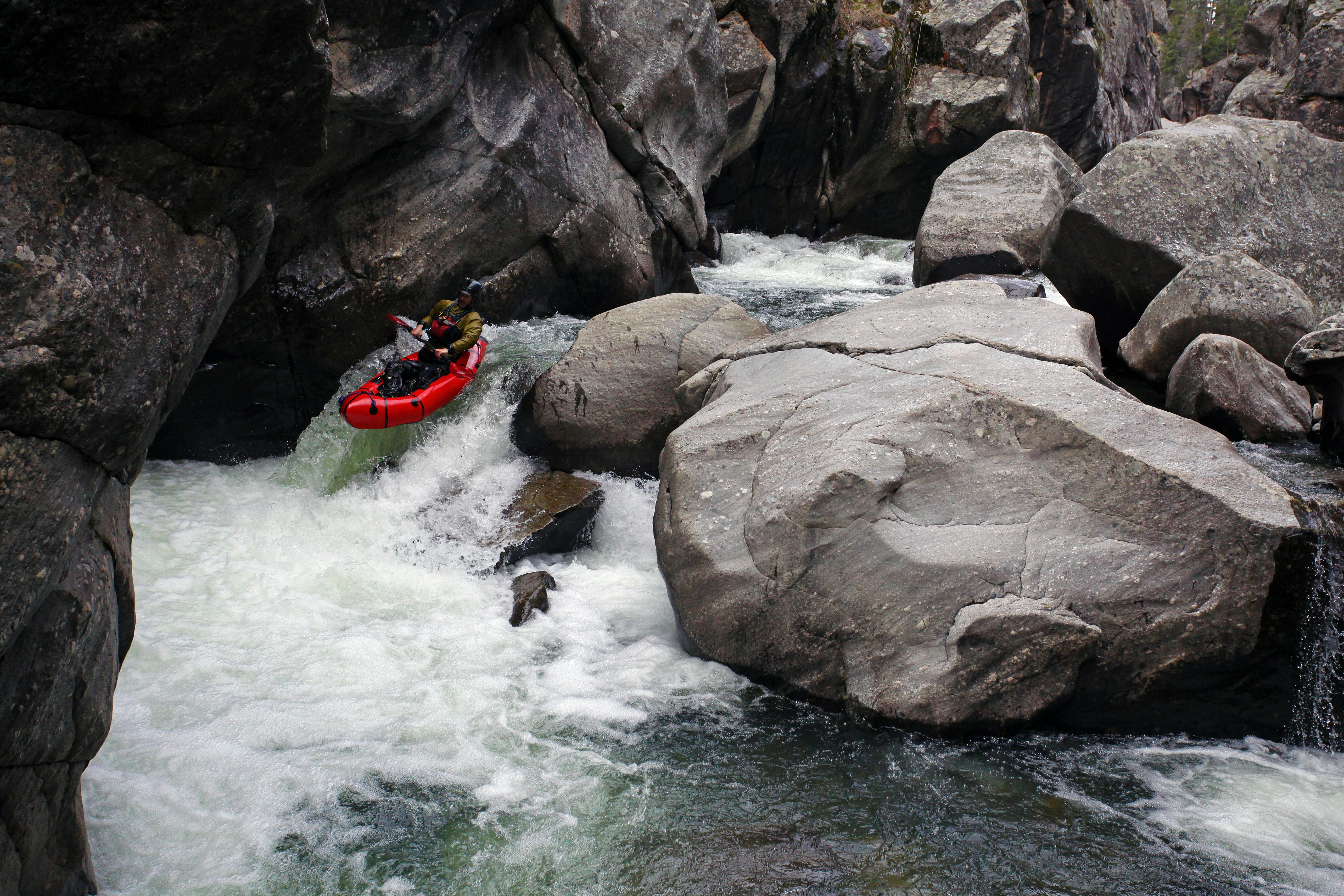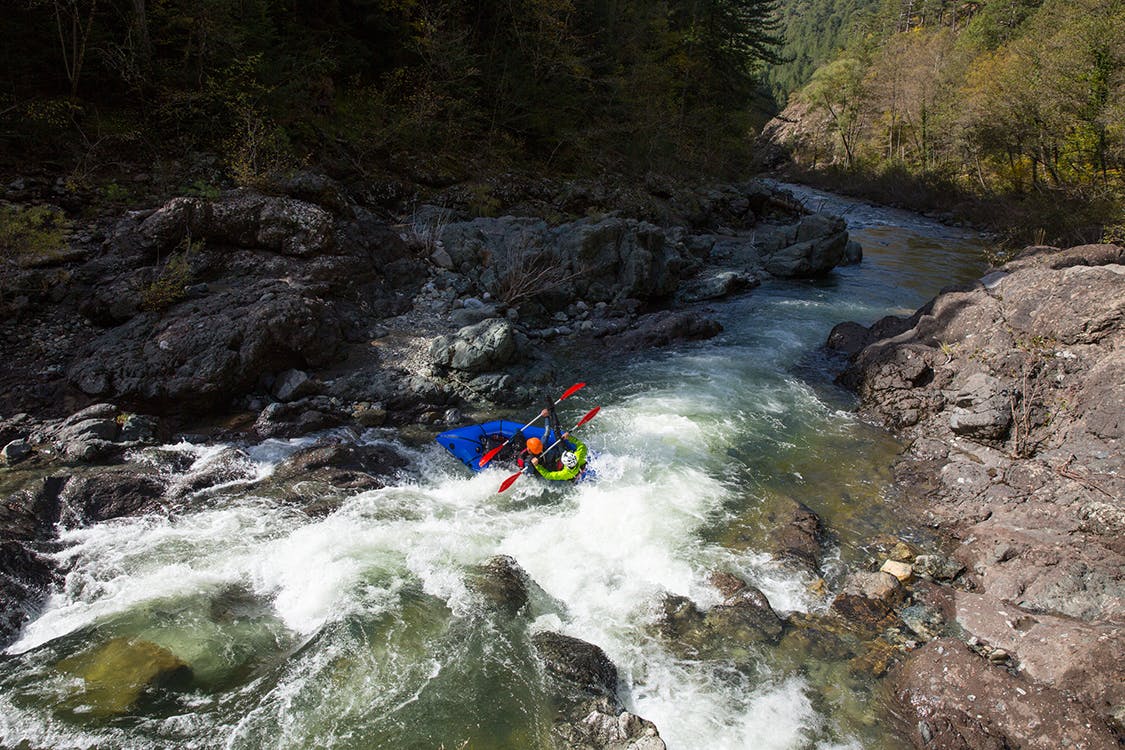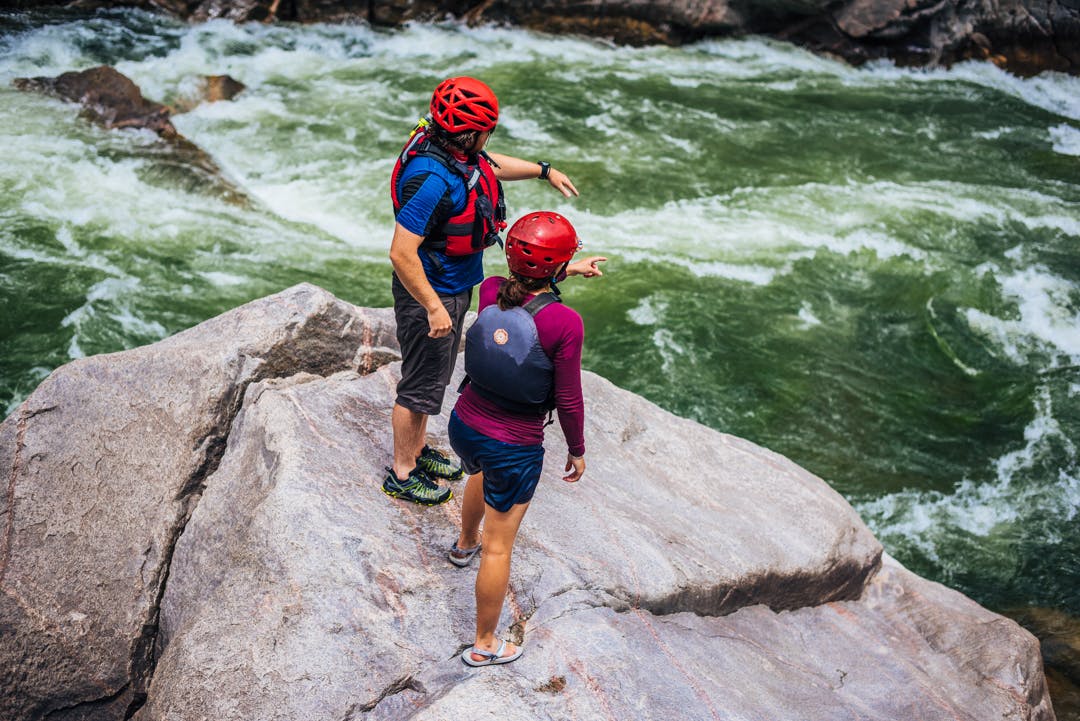Understanding Risk & Packrafting Safety
In the second of this three-part series, we explore how to alleviate the dangers of swiftwater travel, including: the basics of reading water; anticipating river flow and force; how bends, gradient, and constrictions change river flow; understanding river features: eddies, waves, and holes; reading rapids; and river hazards to avoid – floods and trees. Check out Part I here.
By Chad Oelke
The first way to minimize accidents while packrafting is to understand the dangers of swiftwater travel. It is impossible to avoid river hazards if you cannot recognize them or know how they are formed. Therefore, a critical skill for packrafters to stay safe on the river is to gain knowledge about basic hydrology and learn how to “read” water.
As discussed in Part I, the right safety gear and learning how to use it is the second way we can stay safe packrafting. The proper gear can keep you warm and dry while paddling icy creeks, or help rescue a buddy who flipped his boat. Building a solid foundation of paddling skills, such as learning to ferry and eddy out, is also essential to run more challenging whitewater and minimize accidents on the river.
Building solid river judgement is the ultimate goal of packrafting safety. Judgement cannot be easily quantified because it comes from the sum of our knowledge, skills, and experience. However, good river judgement cannot come without time spent running rivers, honing our skills and learning from our mistakes. Good judgement will help us become self-reliant boaters who know to expect the unexpected, and optimize risk based on imprecise knowledge[i]. The ultimate goal of good judgement is not to insulate ourselves from danger, but understand the consequences of our actions and the risks we are willing to take.

Understanding the Dangers of Swiftwater Travel
The Basics of Reading Water
Water is usually boring. It wants to go straight, down, and fill empty spaces. If water was a book and always acted like this, it would be as thrilling to read as the dictionary. Water gets fun when something changes its normally boring flow—or laminar flow—into something that acts against the main direction of the current. These changes to laminar flow will create distinctive features on the river. To “read water” is to be able to recognize these features and choose the best path, or line, down the river.
Anticipating River Flow & Force
We should always shave some idea whether the river we want to run is at a safe flow before we commit to a trip. The flow of rivers is typically measured in cubic feet per second, or cfsSince the weight of water is 62.4 lbs/cubic foot, even relatively slow moving water is surprisingly strong. College football coaches wince at getting dumped with one icy Gatorade cooler after winning a championship; imagine that same coach being dumped with a dozen coolers at once and you can start to picture the force of even small rapids.
As flow increases, the force of water may dramatically increase. You will need to paddle harder to fight strong currents, and have less time to react to hazards in faster moving water. The consequences of a swim will also be more serious: waves may pin you against a rock, or you may be unable to escape out of a strong eddy. As a result, take high water seriously and follow whitewater mantra #1: Respect the power of the river.
Packrafts allow us to run remote creeks and rivers that typically would have required expensive bush flights or heinous portages. The price we pay for running these waters is unpredictability. A sudden rainstorm may cause rapid increases in river volume, making the river more powerful and dangerous to run.
In contrast, the flows of most commercially run rivers in the Lower 48 are fairly predictable. In between Tinder swipes, we can check websites (with USGS gauges) for minute by minute cfs levels of our favorite roadside river run. Unfortunately there is no app for predicting the flows of a remote creek in the Alaska Range, or Utah’s Muddy River during spring run-off. We can make educated guesses based on a number of factors—the color of the water, amount of recent rains, or depth of winter snow pack—but we should always expect the unexpected. Rivers can rise rapidly and unpredictably. Even tame Class I rivers can become filled with boat-flipping eddy lines and woman-eating waves at high water. Whitewater mantra #2: we recommend you not boat a river in flood stage.
Understanding River Features: Eddies, Waves, and Holes

When there is a space behind a rock, tree, or other feature in the river, water will try and fill the hole. The flow will often go backwards against the main current, creating an eddy. You can easily recognize eddies by small whirpools or swirling current made by the circular flow of water as it tries to fill in the gaps behind features. The line between a distinct eddy and the main current (or laminar flow) of the river is an eddy fence.
Eddies are invaluable to recognize because they can be used to help slow down your boat to safely land onshore or “stop” in the middle of a rapid to scout. If you are running an unfamiliar river you can “hop” from eddy to eddy in order to look for hazards ahead.
When water flows over an obstruction, such as a rock or tree, it will form a wave or pourover. If the gap behind the obstruction is big enough, the water will rapidly rush to fill the space and create a holeThe best way to recognize pourovers or holes is to look for a flat horizon line on the river, or a bubbling mass of white made by the chaotic flow of the water. Whitewater occurs when a river’s gradient increases enough to change laminar flow into turbulence, which appears as a bubbly, or aerated current[ii]. Hydrology becomes more than just academics when the size and power of the river increases enough to create rapids.
How Bends, Gradient, & Constrictions Change River Flow
The structure of the river can change the speed of water. Much like turning a yo-yo into a weapon when you swing it around your head, water will accelerate and gain speed as it goes around corners. The increased speed (and force) of the river will chip away at whatever is on the outside bend, creating cutbanksThe slower water on the inside of the bend will build sediment, which will create shoals or sandbars.
The important thing to remember is that the fastest, deepest water will typically be around the outside bend of the river; the slowest, shallowest water in the inside bend. Knowing simple facts like this can help you choose the deepest channel in a braided river or use the slower current of a river bend to scout unknown water downstream.
Gradient will also impact a river’s flow. The steeper the gradient, the more force the river will have. This simple fact can help you imagine unknown stretches of water. If the river drops gradually, from 1500’ to 1000’ over ten miles, you may be able to anticipate a relatively consistent class of whitewater. If you notice, however, that the river drops 300’ in a three mile section, then you can guess that there may be more significant rapids in that section.
As anyone who has put their thumb over a dribbling garden hose and turned it into a pressure washer knows, constriction also increases the speed and force of water. If the canyon walls of the placid creek you are running quickly begin to narrow, and you hear an ominous rumbling in the distance that sounds like a battle scene from Lord of the Rings, it is probably a good time to think about eddying out.
Obstructions at or below the surface of the river will dramatically change how water behaves. Because we (hopefully) spend most of our time on the river’s surface, reading the features that form from rocks, trees, and other submerged objects will be our primary concern on the water.
Reading Rapids; Or, 50 Shades of Whitewater

Rapids are generally produced by three things: increased gradient, increased construction, and the size and shape of obstructions. Combined with the force of water in the river, you can think of rapids as an equation: rapids= flow + gradient + constriction + obstructions. Each one of these factors is an input whose sum may or may not equal a rapid.
Water gets fun to read when all these factors come together to create crashing waves, boiling eddies, and all kinds of spicy hydraulics too hot to summarize in one blog post. Learning how to run rapids is beyond the scope of this article; generally, you’ll want to hit waves head on, aim for glassy water or “V’s”, and avoid big, white frowning holes. An obvious, but very important point is that as water drops from height or gains speed, it gains force. Rapids are dangerous because the force of waterand consequences of a swim are greater than flatter sections of the river.
Rapids are rated from Class I to VI. The difference between whitewater classes is fairly subjective, but is generally is an assessment of how “risky” the rapid is: how exposed you are to objective hazards and the consequences of a flipped boat or swim. Class I may be a lazy river, where the greatest hazards is getting your toes nipped by a hungry Largemouth Bass. A Class V rapid may require tight maneuvering between massive boulders to avoid boat-eating holes and dangerous undercuts.
Rating rapids is like wine-tasting. Two people drink the same Pinot Noir: one says it has hints of lemongrass and petrol; the other says aromas of cedar and buffalo dung. The point being is that they both may have no idea what they are talking about. The same goes with rapids. One boater may call a creek “hard Class II”, while another may call it “easy Class III”. You may run the river, see a few rifles and minor wavetrains and call it Class I. Reserve a healthy suspicion for how others grade whitewater, and as a rule:
Whitewater mantras #3 and #4: Never run water that you aren’t willing to swim.
River Hazards to Avoid: Floods & Trees
Fast, powerful water can also increase the danger of foot entrapments, entanglements, and strainers. Entanglements are any kind of loose rope, fishing line, or thingamajig that wraps itself around you and limits your movement in water. Eliminate unnecessary loose rope on your boat or person to minimize entanglements. Foot entrapments, or pins, occur when the force of water holds you against an obstruction. The best way to avoid entrapments is to never stand up in water and portage around rapids where the threat of a pin is uncommonly high. Strainers are trees or logs in the river that act just like your spaghetti strainer at home: water goes through, people and boats do not.
Strainers are the arguably the single most dangerous hazard to packrafters because they are common on the small rivers and creeks we run. They are not choosy about where they hide; a spruce tree that sneaks up on you around a tight bend of Class I water can be more dangerous than running a Class III rapid that flushes into a large, deep pool. For this reason, strainers can make even “easy” whitewater dangerous. Packrafters should always aggressively avoid strainers and portage around them if necessary.
In Sum, rivers are dangerous until proven otherwise. One of the great things about this sport is the ease and convenience of getting out there. Do you spend an hour hacking through a half mile of willow bushes to portage a rapid? Or, do you take five minutes to run that Class IV chute, even though you know it looks like there may be some nasty rocks to get pinned on? Because of strainers, unpredictable flows, or other unforeseen hazards, we should never assume that a Class I river will be “easy” or “safe” unless proven otherwise. Whitewater mantra #5 is: Always scout unknown water.
Stay tuned for Part III, to be published next Friday. We’ll be exploring ways to mitigate the dangers of packrafting through: acquiring paddling skills and quickly responding to hazards; how to gain experience and good judgement; common causes of accidents; and how to manage risk when running unknown water.
Chad Oelke first learned the value of swiftwater rescue during two seasons as a commercial raft guide. Recently, he has honed his safety skills working as a Backcountry Ranger for the NPS in Alaska. Although the sunny oak forests of Northern California are his native home, the author prefers the bog and brush of Interior Alaska to almost anywhere else on the planet. Besides packrafting, his hobbies also include kayaking, fly-fishing, and endlessly fixing his 91′ Toyota Pickup.
[i] Wilde, G.J.S. (2014). Target Risk 3: Risk Homeostasis in Everyday Life. Toronto, PDE Publications; Castor & Columbia.
[ii] Phillips, Ken. (2012). National Park Service Swiftwater Rescue Manual. Washington D.C., District of Columbia: Department of the Interior, National Park Service. P.8.